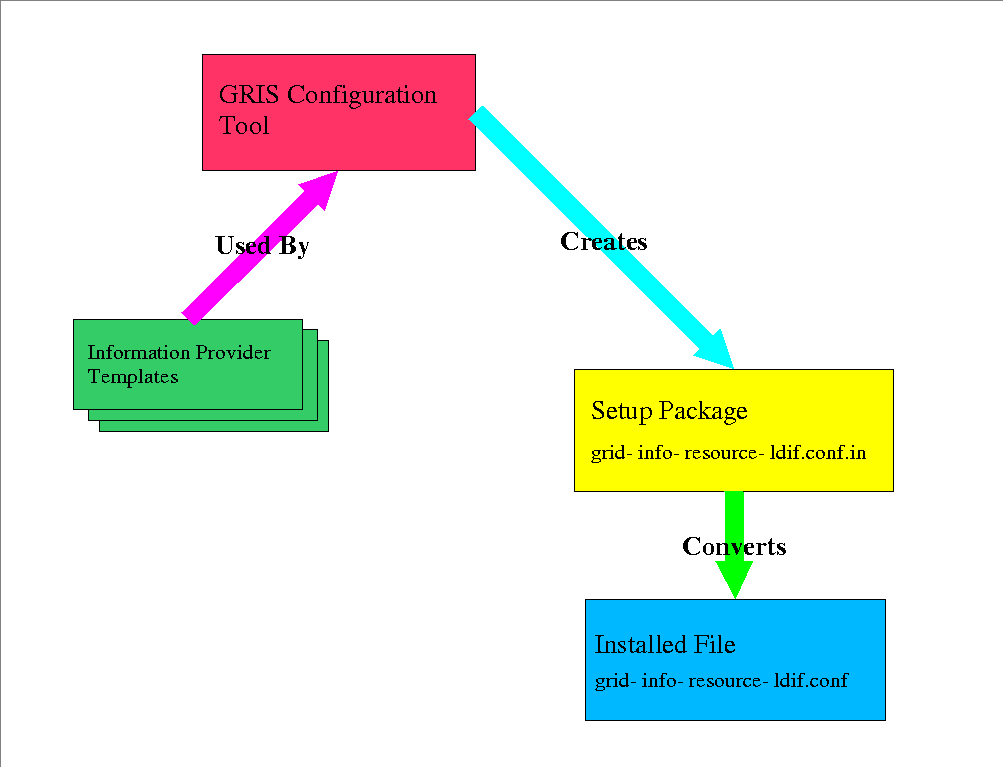MDS Deployment and Configuration
Introduction
The Meta Directory Service (MDS) is a special problem for Grid
deployment since it is designed to publish information that is
unique to a particular machine, site, or grid. The deployment
problem has changed with the adoption of the Grid Packaging
Technology (GPT) as the deployment mechanism for the Globus
Toolkit. This paper summarizes a discussion held with John McGee
of ISI. This discussion focused on the final configuration
solution and intermediate solutions that could be implemented now.
A description of the various configuration files for MDS can be
found here.
The configuration focuses on three areas:
- GRIS Configuration
- This
configuraion has two parts. The first part defines what
information providers are available. The second part defines
which GIIS's need the information
- GIIS Configuration
- This
configuration requires a list of GRIS's that are sending
information and a schema defining how the ldif objects sent by
the GRIS's should be organinzed.
- SLAPD Backend Configuration
- This
configuration defines what backends are used by the slapd
service.
Deployment Methods in a Package Environment
Using packages for deployment requires a change in deployment methods.
- Adding functionality to a component needs to be done by
adding additional packages.
- Localization of files to add host specific information needs
to be done using pre/post install scripts.
- Pre/post install scripts and the templates the used need to
be deployed as setup packages that are seperate from the
packages containing the source code and installed binaries
Deploying Information Providers
Each GRIS manages a set of information providers that are defined
in the configuration file grid-info-resource-ldif.conf.
Currently the MDS deploys a default set of information providers,
but the design of MDS allows for other information providers to be
added on a site or grid basis. To actually implement this though
takes some thought.
The final solution
grid-info-resource-ldif.conf
needs to go through two sets of converions. As illustrated by the
following diagram

The information providers start with a set of template files that
are deployed via packages with an overall GRIS configuration tool.
The tool allows a user to select a set of information providers
and then generates a setup package containing a
grid-info-resource-ldif.conf.in file which defines the
set. After this setup package is installed, a post install script
is run to localize the file to the host.
A similar solution would need to be provided for the file
grid-info-resource.schema.
Interim Solution
In the meantime procedures for
assembling a set of information providers and for defining a new
information provider needs to be written. From this grid-centric
GRIS setup packages can then be created.
Deploying GRIS to GIIS Registration Information
Both the
GRIS and the GIIS need to be able to know who to talk to. This information is contained in the following files:
- grid-info-resource-register.conf
- Lists the GIIS servers to which this GRIS will register directly.
- grid-info-site-policy.conf
- Controls
acceptance of incoming GRIS registrations
For a typical virtual organization the identity of the GIIS's are
known beforehand. This information can thus be included in a
GRIS setup package created by the organization. Unfortunately
the identity of all of the GRIS's cannot always be known
beforehand. The file grid-info-site-policy.conf is
designed to accept regular expressions such as wildcards so that
a set of GRIS's can be identified. Unfortunately these
expressions are currently based on the DNS of the GRIS.
Final Solution
Add the list of GIIS's to the setup
package created by the GRIS configuration tool. Change the format
of the file grid-info-site-policy.conf so that the
expressions are based on the GSI distinguished name. In this way
GRIS's can be registered by the virtual organisation distinguished
name.
Interim Solution
Virtual organizations need a tool that
will manage the list of GRIS's in the
grid-info-site-policy.conf file. Some perfomance
measurements are also need to see what effect large GRIS lists
will have.
Deploying SLAPD Backends
The slapd demon is designed so
that backend can be added and removed without recompiling the
demon. The file grid-info-slapd.conf is used by slapd to
identify these backends. Ideally the backends should be deployed
as separate packages. Unfortunately this is not possible because
of the grid-info-slapd.conf which has to list all
of the backends the slapd demon should load.
Final Solution
The slapd demon needs to be modified so
that a separate configuration file for each backend is read. This
is similar to what is done for the xinetd demon.
Interim Solution
Seperate sets of backends need to run
there own slapd demon. For example the MDS backends are deployed
seperately from the Network Weather Service backend. If both sets
are deployed on the same host then two slapd demons need to run.
Michael Bletzinger
Last modified: Tue Mar 19 17:47:36 CST 2002
